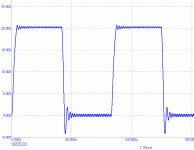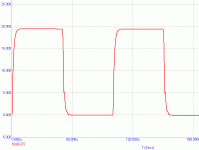Hi Edmond
think you got the wrong interpretation. Always oscillated/ringing with 2uF load, but less to negligible with resistive load (with or without coil).
I haven't tried 2uF without either a damping resistor in parallel, but imagine it will be worse if there is no 8 ohm load in parallel.
cheers
John
think you got the wrong interpretation. Always oscillated/ringing with 2uF load, but less to negligible with resistive load (with or without coil).
I haven't tried 2uF without either a damping resistor in parallel, but imagine it will be worse if there is no 8 ohm load in parallel.
cheers
John
An the 2nd one is a not very well known DIY project, same conditions.
These are simulation results. Measurement on real amplifiers gives worse results. The 1st amp becomes unstable, and the 2nd one shows 3 quickly damped halfwaves, so it is stable.
The 1st amp has a Zobel and no coil, the 2nd amp has neither Zobel nor coil.
These are simulation results. Measurement on real amplifiers gives worse results. The 1st amp becomes unstable, and the 2nd one shows 3 quickly damped halfwaves, so it is stable.
The 1st amp has a Zobel and no coil, the 2nd amp has neither Zobel nor coil.
Attachments
I also worried about output coils for more than 40 years.
But one day i had an insigth reading a text about our brain activity.
Our brain is many times better than a supercomputer related processing of data....we have many processors running at same time, and they have "conversations" between them.....better than dual core, triple core or anything you can imagine.
But the processing is electro chemical...... those processes delay time....nothing is instantaneous..... the square wave Pavel offered may be an instrument generation signal.... very fast.
But imagine what happens when this enters our brain.... the final processing.... something alike very slow slew rate happens.... the increasing time, the rising time will be very slow...imagine the shape of the waveform "translated", or "perceived" by the brain....... also the decay time is low in speed.....imagine what happens.
The square wave will be more a sinusoidal...having small flat time.. and spikes and ringing are simply "erased" from our brain processing.
Well...this is what you brain translates......if you pick the signal inside brain and put it into waveform monitor.
But there exist another problem.... the result of brain's output processing do not goes to scopes..... they go to your perception center...where your sensorial stimulum goes.... audio perception has a sector inside your brain, and it is connected to other brain areas.
Something you can describe as "taste" will affect the judgment...reason why there are people that perceive square waves as not so annoying and others that hate that sound.
We are much more than waveform monitors folks.
regards,
Carlos
But one day i had an insigth reading a text about our brain activity.
Our brain is many times better than a supercomputer related processing of data....we have many processors running at same time, and they have "conversations" between them.....better than dual core, triple core or anything you can imagine.
But the processing is electro chemical...... those processes delay time....nothing is instantaneous..... the square wave Pavel offered may be an instrument generation signal.... very fast.
But imagine what happens when this enters our brain.... the final processing.... something alike very slow slew rate happens.... the increasing time, the rising time will be very slow...imagine the shape of the waveform "translated", or "perceived" by the brain....... also the decay time is low in speed.....imagine what happens.
The square wave will be more a sinusoidal...having small flat time.. and spikes and ringing are simply "erased" from our brain processing.
Well...this is what you brain translates......if you pick the signal inside brain and put it into waveform monitor.
But there exist another problem.... the result of brain's output processing do not goes to scopes..... they go to your perception center...where your sensorial stimulum goes.... audio perception has a sector inside your brain, and it is connected to other brain areas.
Something you can describe as "taste" will affect the judgment...reason why there are people that perceive square waves as not so annoying and others that hate that sound.
We are much more than waveform monitors folks.
regards,
Carlos
Good point, Carlos 😉
Anyway, the square wave (step response) shows that under certain conditions the amp may start to oscillate. The steep rise does not necessarily need to arrive from musical signal (impossible), but can be a result of RFI interference, EMI troughput from mains network etc. So, the amp must be stable when excitated by square wave. The matter of question is the capacitive load of several uF, which is usually unreal.
Anyway, the square wave (step response) shows that under certain conditions the amp may start to oscillate. The steep rise does not necessarily need to arrive from musical signal (impossible), but can be a result of RFI interference, EMI troughput from mains network etc. So, the amp must be stable when excitated by square wave. The matter of question is the capacitive load of several uF, which is usually unreal.
Yes Pavel, i know that the oscilation start do not depends from our perception
And worries about that make sense.
I am just informing that "what we see at scope" may be precise as visual informations...but not so precise as audible information.
regards,
Carlos
And worries about that make sense.
I am just informing that "what we see at scope" may be precise as visual informations...but not so precise as audible information.
regards,
Carlos
Waw, I'm guessing right 😀
There are some topologies (not many) that tends to be more stable with more capacitive load.
Hi, Hartono,
Anda sudah berapa lama membuat amplifier? Sptnya sudah lama, banyak pengalamannya. Bisa bagi-bagi ilmu? 😀
There are some topologies (not many) that tends to be more stable with more capacitive load.
Hi, Hartono,
Anda sudah berapa lama membuat amplifier? Sptnya sudah lama, banyak pengalamannya. Bisa bagi-bagi ilmu? 😀
"There are some topologies (not many) that tends to be more stable with more capacitive load."
yes, but how about inductive load ? 😀
I didn't make that much amp Lumanauw , are you the one in Bandung who own CD and audio store ??
Hartono
yes, but how about inductive load ? 😀
I didn't make that much amp Lumanauw , are you the one in Bandung who own CD and audio store ??
Hartono
Hi, Jacco,
What is the meaning of "having is not yet spending"?
Hi, Hartono,
What are you doing in China?
What is the meaning of "having is not yet spending"?
Hi, Hartono,
What are you doing in China?
- Status
- Not open for further replies.
- Home
- Amplifiers
- Solid State
- Output coil on power amp...

